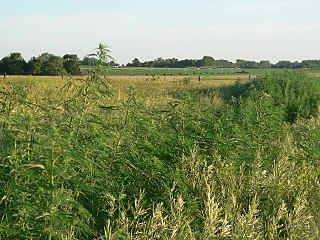
Humboldt County is a county located in the U.S. state of California. As of the 2020 census, the population was 136,463. The county seat is Eureka.

The Drug Enforcement Administration (DEA) is a United States federal law enforcement agency under the U.S. Department of Justice tasked with combating illicit drug trafficking and distribution within the U.S. It is the lead agency for domestic enforcement of the Controlled Substances Act, sharing concurrent jurisdiction with the Federal Bureau of Investigation, the U.S. Immigration and Customs Enforcement, and U.S. Customs and Border Protection. However, the DEA has sole responsibility for coordinating and pursuing U.S. drug investigations both domestically and internationally.

Proposition 215, or the Compassionate Use Act of 1996, is a California law permitting the use of medical cannabis despite marijuana's lack of the normal Food and Drug Administration testing for safety and efficacy. It was enacted, on November 5, 1996, by means of the initiative process, and passed with 5,382,915 (55.6%) votes in favor and 4,301,960 (44.4%) against.

The Emerald Triangle is a region in Northern California, named as such due to it being the largest cannabis-producing region in the United States. The region includes three counties in an upside-down triangular configuration:

Feral cannabis, or wild marijuana, is wild-growing cannabis generally descended from industrial hemp plants previously cultivated for fiber, with low or negligible amounts of psychoactive tetrahydrocannabinol (THC).

Garberville is a census-designated place in Humboldt County, California. It is located on the South Fork of the Eel River 52 miles (84 km) south-southeast of Eureka, at an elevation of 535 feet (163 m). The population was 913 at the 2010 United States Census. It is approximately 200 miles (320 km) north of San Francisco, California, and within a fifteen-minute drive to Humboldt Redwoods State Park and a sixty-minute drive to Eureka, the county seat. Garberville is the primary town in the area known as the Mateel Region, consisting of parts of the Mattole and Eel River watersheds in southern Humboldt and northern Mendocino counties.
The Guadalajara Cartel also known as The Federation was a Mexican drug cartel which was formed in 1980 by Miguel Ángel Félix Gallardo, Rafael Caro Quintero, and Ernesto Fonseca Carrillo in order to ship cocaine and marijuana to the United States. Among the first of the Mexican drug trafficking groups to work with the Colombian cocaine mafias, the Guadalajara Cartel prospered from the cocaine trade. Throughout the 1980s, the cartel controlled much of the drug trafficking in Mexico and the corridors along the Mexico–United States border. It had operations in various regions in Mexico which included the states of Jalisco, Baja California, Colima, Sonora, Chihuahua and Sinaloa among others. Multiple modern present day drug cartels such as the Tijuana, Juárez and Sinaloa cartels originally started out as branches or "plazas" of the Guadalajara Cartel before its eventual disintegration.
Valerie Leveroni Corral is an American medical cannabis activist and writer. As a young adult she experienced a traumatic head injury that left her with a seizure disorder that antiepileptic medication could not ameliorate. Her experimental use of cannabis to treat her seizures led her to grow it on her property in Santa Cruz, California. In 1992, she was arrested for cannabis cultivation, becoming the first person in that state to argue the medical necessity defense. Following her success, she founded the Wo/Men's Alliance for Medical Marijuana (WAMM) and was a coauthor of Proposition 215, the first medical cannabis state ballot initiative to pass in the United States.

Cannabis in Oregon is legal for both medical and recreational use. In recent decades, the U.S. state of Oregon has had a number of legislative, legal, and cultural events surrounding use of cannabis. Oregon was the first state to decriminalize the possession of small amounts of cannabis, and among the first to authorize its use for medical purposes. An attempt to recriminalize possession of small amounts of cannabis was turned down by Oregon voters in 1997.
Operation Green Sweep was a series of drug raids conducted by over 200 United States Army soldiers, National Guardsmen, and federal agents in Humboldt County, California. The operation was the first time active-duty troops were used to combat marijuana growing in the United States. The joint federal and state operation led by the Bureau of Land Management was centered around eradicating marijuana and removing agribusiness paraphernalia from the King Range National Conservation Area, federal land administered by BLM near Petrolia, California.

Cannabis in California has been legal for medical use since 1996, and for recreational use since late 2016. The state of California has been at the forefront of efforts to liberalize cannabis laws in the United States, beginning in 1972 with the nation's first ballot initiative attempting to legalize cannabis. Although it was unsuccessful, California would later become the first state to legalize medical cannabis through the Compassionate Use Act of 1996, which passed with 56% voter approval. In November 2016, California voters approved the Adult Use of Marijuana Act with 57% of the vote, which legalized the recreational use of cannabis.

Enrique "Kiki" Camarena Salazar was an American intelligence officer for the Drug Enforcement Administration (DEA). In February 1985 Camarena was kidnapped by drug traffickers hired by Mexican politicians in Guadalajara, Mexico. He was interrogated under torture and murdered. Three leaders of the Guadalajara drug cartel were eventually convicted in Mexico for Camarena's murder. The U.S. investigation into Camarena's murder led to ten more trials in Los Angeles for other Mexican nationals involved in the crime. The case continues to trouble U.S.–Mexican relations, most recently when Rafael Caro Quintero, one of the three convicted traffickers, was released from a Mexican prison in 2013. Caro Quintero again was captured by Mexican forces in July 2022.

The California Bureau of Narcotic Enforcement (BNE) was a drug law enforcement agency, under the California Department of Justice. The BNE was established in 1927, and was the oldest narcotic enforcement bureau in the United States at the time of it disbanding. In 2012, elements of the BNE were merged with its sister bureau forming the new California Bureau of Investigation. Today, the CBI has taken over some of the former BNE's operations that had not been completely eliminated.
The Domestic Cannabis Eradication/Suppression Program is a Drug Enforcement Administration-funded program to eradicate cannabis in the United States. DEA began the program in 1979 during the War on Drugs. In the first few years of the Reagan administration, the program expanded from seven states to forty. By 1985 it was active in all fifty states.
The cannabis policy of the Reagan administration involved affirmation of the War on Drugs, government funded anti-cannabis media campaigns, expanded funding for law enforcement, involvement of the U.S. military in interdiction and eradication, reduction in emphasis in drug treatment, and creation of new Federal powers to test employees and seize cannabis-related assets.
Pot Cops is an American reality television series that aired on the Discovery Channel. The show premiered on February 20, 2013, during Discovery Channel's programming block titled "Weed Wednesdays", along with Weed Country. The series followed dealers, growers and patients of the marijuana trade in Humboldt County, California, located within the Emerald Triangle, along with the enforcers of the law at the Humboldt County Sheriff's office. Well known Humboldt County grower Timothy Littlefield is featured prominently in an episode where a garden was raided in a joint investigation with the Humboldt County Sheriff's Office and the Bureau of Indian Affairs Police. Pot Cops highlighted the difficulty that Humboldt County law enforcement officers faced in enforcing marijuana laws in California, after the passage of Proposition 215 in 1996 and before Proposition 64 in 2016.
Sasquatch is an American true crime documentary television series that premiered on Hulu on April 20, 2021, with a South by Southwest pre-release screen on March 16, 2021. The show begins with investigative journalist David Holthouse's recalling a story he heard in 1993 on a cannabis farm in Mendocino County, part of the Emerald Triangle in Northern California. Holthouse heard someone say that Bigfoot has killed three people on a nearby cannabis farm. Throughout the show Holthouse talks with marijuana growers and law enforcement in Mendocino County, who tell him about possible connections to the Hells Angels biker gang and Spy Rock Road, a lawless marijuana growing area of Mendocino County near Laytonville. These interviews reveal the larger problem of missing persons in the Emerald Triangle.
The Kentucky Marijuana Strike Force, also known as the Kentucky Governor's Marijuana Strike/Task Force, is a multi-agency law enforcement task force managed by the Office of the Governor of Kentucky and Kentucky State Police Marijuana Suppression Branch, and composed of local, state and federal agencies organized expressly to eradicate illegal cannabis cultivation and trafficking in Kentucky. The task force was established in 1990, to combat marijuana cultivation on public lands in Kentucky that ranks third in the United States, behind California and Tennessee. An estimated $1 billion worth of marijuana is seized in Kentucky annually.
The Tennessee Governor's Task Force on Marijuana Eradication (GTFME), a multi-agency law enforcement task force founded in 1983, is managed by the Office of the Governor of Tennessee composed of local, state agencies organized expressly to eradicate illegal cannabis cultivation and trafficking in Tennessee. The Governor's Task Force is operated by the Tennessee Bureau of Investigation's Tennessee Dangerous Drugs Task Force. The eradication season lasts from May through September in Tennessee, where outdoor marijuana cultivation ranks second in the United States, behind California. The task force, divided into three regional teams, East, Middle and West, centralized marijuana eradication in the state into a coordinated multi-agency program.
Sequoia County was a proposal in the early 1990s, to create a new county out of parts of Southern Humboldt and Northern Mendocino counties in California. The 1992 proposal halted signature gathering due to low support. The proponents of the proposal, restarted in 1993, submitted signatures in January 1994 to the Humboldt County clerk, who validated 2,033 signatures, 169 short of the necessary number to qualify for possible inclusion on the 1996 ballot.










